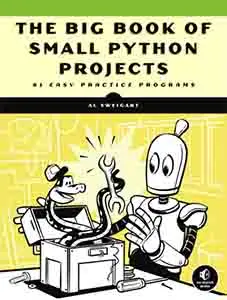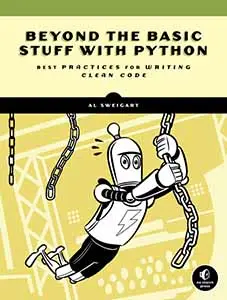







Use this link to get 70% off the Automate the Boring Stuff online video course.
Support me on Patreon









Three-card monte is a common scam played on gullible tourists and other easy marks. Three playing cards, one of which is the “red lady” Queen of Hearts, are put facedown on a cardboard box. The dealer quickly rearranges the cards and then asks the mark to pick the Queen of Hearts. But the dealer can use all sorts of tricks to hide the card or otherwise cheat, guaranteeing that the victim never wins. It’s also common for the dealer to have shills in the crowd who secretly work with the dealer but pretend to win the game (to make the victim think they too could win) or purposefully lose badly (to make the victim think they could do much better).
This program shows the three cards and then quickly describes a series of swaps. At the end, it clears the screen, and the player must pick a card. Can you keep up with the “red lady”? For the authentic three-card monte experience, you can enable the cheat feature, which causes the player to always lose, even if they select the correct card.
When you run threecardmonte.py, the output will look like this:
Three-Card Monte, by Al Sweigart [email protected]
Find the red lady (the Queen of Hearts)! Keep an eye on how
the cards move.
Here are the cards:
___ ___ ___
|J | |Q | |8 |
| ♦ | | ♥ | | ♣ |
|__J| |__Q| |__8|
Press Enter when you are ready to begin...
swapping left and middle...
swapping right and middle...
swapping middle and left...
swapping right and left...
swapping left and middle...
--snip--
<screen clears>
Which card has the Queen of Hearts? (LEFT MIDDLE RIGHT)
> middle
___ ___ ___
|Q | |8 | |J |
| ♥ | | ♣ | | ♦ |
|__Q| |__8| |__J|
You lost!
Thanks for playing, sucker!In this program, we use a (rank, suit) tuple to represent a playing card. The rank is a string representing the card number, such as '2', '10', 'Q', or 'K', and the suit is a string of either a heart, club, spade, or diamond emoji. Since you cannot enter the emoji character using your keyboard, we’ll use the chr() function calls on lines 16 to 19 to produce them. The tuple ('9', '♦') represents the nine of diamonds.
Instead of printing these tuples directly, the displayCards() function on lines 28 to 43 interprets them and displays ASCII-art representations on the screen, like in Project 4, “Blackjack.” The cards argument for this function is a list of the playing card tuples, allowing multiple cards to be displayed in a row.
1. """Three-Card Monte, by Al Sweigart [email protected]
2. Find the Queen of Hearts after cards have been swapped around.
3. (In the real-life version, the scammer palms the Queen of Hearts so you
4. always lose.)
5. More info at https://en.wikipedia.org/wiki/Three-card_Monte
6. This code is available at https://nostarch.com/big-book-small-python-programming
7. Tags: large, card game, game"""
8.
9. import random, time
10.
11. # Set up the constants:
12. NUM_SWAPS = 16 # (!) Try changing this to 30 or 100.
13. DELAY = 0.8 # (!) Try changing this 2.0 or 0.0.
14.
15. # The card suit characters:
16. HEARTS = chr(9829) # Character 9829 is '♥'
17. DIAMONDS = chr(9830) # Character 9830 is '♦'
18. SPADES = chr(9824) # Character 9824 is '♠'
19. CLUBS = chr(9827) # Character 9827 is '♣'
20. # A list of chr() codes is at https://inventwithpython.com/chr
21.
22. # The indexes of a 3-card list:
23. LEFT = 0
24. MIDDLE = 1
25. RIGHT = 2
26.
27.
28. def displayCards(cards):
29. """Display the cards in "cards", which is a list of (rank, suit)
30. tuples."""
31. rows = ['', '', '', '', ''] # Stores the text to display.
32.
33. for i, card in enumerate(cards):
34. rank, suit = card # The card is a tuple data structure.
35. rows[0] += ' ___ ' # Print the top line of the card.
36. rows[1] += '|{} | '.format(rank.ljust(2))
37. rows[2] += '| {} | '.format(suit)
38. rows[3] += '|_{}| '.format(rank.rjust(2, '_'))
39.
40.
41. # Print each row on the screen:
42. for i in range(5):
43. print(rows[i])
44.
45.
46. def getRandomCard():
47. """Returns a random card that is NOT the Queen of Hearts."""
48. while True: # Make cards until you get a non-Queen of hearts.
49. rank = random.choice(list('23456789JQKA') + ['10'])
50. suit = random.choice([HEARTS, DIAMONDS, SPADES, CLUBS])
51.
52. # Return the card as long as it's not the Queen of Hearts:
53. if rank != 'Q' and suit != HEARTS:
54. return (rank, suit)
55.
56.
57. print('Three-Card Monte, by Al Sweigart [email protected]')
58. print()
59. print('Find the red lady (the Queen of Hearts)! Keep an eye on how')
60. print('the cards move.')
61. print()
62.
63. # Show the original arrangement:
64. cards = [('Q', HEARTS), getRandomCard(), getRandomCard()]
65. random.shuffle(cards) # Put the Queen of Hearts in a random place.
66. print('Here are the cards:')
67. displayCards(cards)
68. input('Press Enter when you are ready to begin...')
69.
70. # Print the swaps:
71. for i in range(NUM_SWAPS):
72. swap = random.choice(['l-m', 'm-r', 'l-r', 'm-l', 'r-m', 'r-l'])
73.
74. if swap == 'l-m':
75. print('swapping left and middle...')
76. cards[LEFT], cards[MIDDLE] = cards[MIDDLE], cards[LEFT]
77. elif swap == 'm-r':
78. print('swapping middle and right...')
79. cards[MIDDLE], cards[RIGHT] = cards[RIGHT], cards[MIDDLE]
80. elif swap == 'l-r':
81. print('swapping left and right...')
82. cards[LEFT], cards[RIGHT] = cards[RIGHT], cards[LEFT]
83. elif swap == 'm-l':
84. print('swapping middle and left...')
85. cards[MIDDLE], cards[LEFT] = cards[LEFT], cards[MIDDLE]
86. elif swap == 'r-m':
87. print('swapping right and middle...')
88. cards[RIGHT], cards[MIDDLE] = cards[MIDDLE], cards[RIGHT]
89. elif swap == 'r-l':
90. print('swapping right and left...')
91. cards[RIGHT], cards[LEFT] = cards[LEFT], cards[RIGHT]
92.
93. time.sleep(DELAY)
94.
95. # Print several new lines to hide the swaps.
96. print('\n' * 60)
97.
98. # Ask the user to find the red lady:
99. while True: # Keep asking until LEFT, MIDDLE, or RIGHT is entered.
100. print('Which card has the Queen of Hearts? (LEFT MIDDLE RIGHT)')
101. guess = input('> ').upper()
102.
103. # Get the index in cards for the position that the player entered:
104. if guess in ['LEFT', 'MIDDLE', 'RIGHT']:
105. if guess == 'LEFT':
106. guessIndex = 0
107. elif guess == 'MIDDLE':
108. guessIndex = 1
109. elif guess == 'RIGHT':
110. guessIndex = 2
111. break
112.
113. # (!) Uncomment this code to make the player always lose:
114. #if cards[guessIndex] == ('Q', HEARTS):
115. # # Player has won, so let's move the queen.
116. # possibleNewIndexes = [0, 1, 2]
117. # possibleNewIndexes.remove(guessIndex) # Remove the queen's index.
118. # newInd = random.choice(possibleNewIndexes) # Choose a new index.
119. # # Place the queen at the new index:
120. # cards[guessIndex], cards[newInd] = cards[newInd], cards[guessIndex]
121.
122. displayCards(cards) # Show all the cards.
123.
124. # Check if the player won:
125. if cards[guessIndex] == ('Q', HEARTS):
126. print('You won!')
127. print('Thanks for playing!')
128. else:
129. print('You lost!')
130. print('Thanks for playing, sucker!')
After entering the source code and running it a few times, try making experimental changes to it. The comments marked with (!) have suggestions for small changes you can make. On your own, you can also try to figure out how to do the following:
\b characters to erase it before printing the next one.Try to find the answers to the following questions. Experiment with some modifications to the code and rerun the program to see what effect the changes have.
[('Q', HEARTS), getRandomCard(), getRandomCard()] on line 64 to [('Q', HEARTS), ('Q', HEARTS), ('Q', HEARTS)]?list('23456789JQKA') on line 49 to list('ABCDEFGHIJK')?time.sleep(DELAY) on line 93?